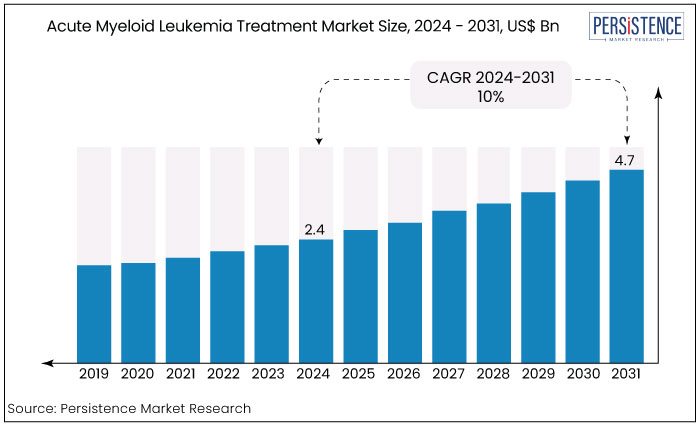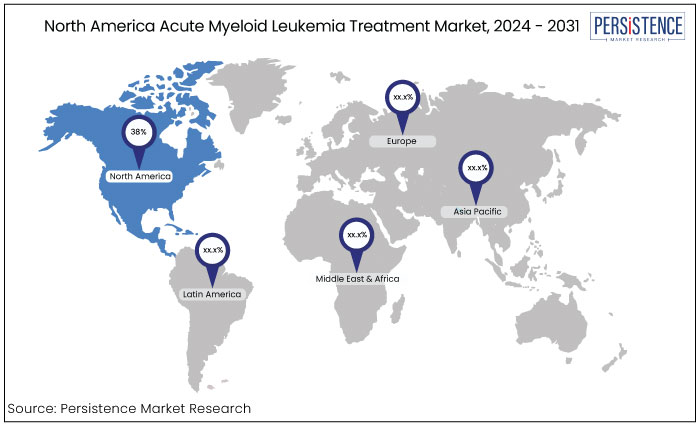Industry: Healthcare
Published Date: September-2024
Format: PPT*, PDF, EXCEL
Delivery Timelines: Contact Sales
Number of Pages: 179
Report ID: PMRREP34810
The acute myeloid leukemia treatment (AML) market is estimated to increase from US$2.4 Bn in 2024 to US$4.7 Bn by 2031. The market is projected to record a CAGR of 10% during the forecast period from 2024 to 2031. The growing emphasis on precision medicine, tailoring treatments based on individual genetic profiles for improved outcomes caters to the market demand over the forecast period. North America dominates the market accumulating around 38% of the total market share.

Key Highlights of the Market
|
Market Attributes |
Key Insights |
|
Acute Myeloid Leukemia Treatment Market Size (2024E) |
US$2.4 Bn |
|
Projected Market Value (2031F) |
US$4.7 Bn |
|
Global Market Growth Rate (CAGR 2024 to 2031) |
10% |
|
Historical Market Growth Rate (CAGR 2019 to 2023) |
9.4% |
|
Region |
Market Share in 2024 |
|
North America |
38% |
North America market to account for 38% share. North America market is experiencing numerous significant changes. A notable trend is the growing utilization of targeted treatments and immunotherapies in the treatment of AML.
These novel therapies are demonstrating efficacy in clinical studies and are anticipated to transform AML treatment in the region. Increasing emphasis on precision medicine methodologies, which seek to customize treatment regimens according to the genetic profiles of particular patients.
The U.S. acute myeloid leukemia therapy industry is significantly impacted by the rigorous regulatory framework overseeing medication approvals and clinical studies. The U.S. Food and Drug Administration (FDA) plays a vital role in the assessment and authorization of novel AML therapies guaranteeing compliance with patient safety and efficacy criteria.
The substantial healthcare expenditure in the United States. facilitates patient access to improved treatments hence accelerating the adoption of innovative medicines in the market.

|
Category |
Market Share in 2024 |
|
Disease - Myeloblastic Leukemia |
45% |
Based on disease, the market is divided into myeloblastic leukemia, myelomonocytic, leukemia, and promyelocytic leukemia. Among these, the myeloblastic leukemia dominates the market.
The myeloblastic leukemia segment represented the significant market share owing to the high incidence and prevalence of this disease category, which generates substantial demand for effective therapies.
Growth of this segment is further bolstered by the ongoing advancement of novel medicines and the enhancement of current treatments. In July 2023, the FDA sanctioned a novel targeted therapy for AML, quizartinib, in conjunction with traditional chemotherapeutic regimens, precisely targeting genetic alterations in some AML patients.
|
Category |
Market Share in 2024 |
|
Treatment - Chemotherapy |
50% |
Based on treatment, the market is further divided into chemotherapy, targeted therapy, and immunotherapy, where the chemotherapy treatment segment dominates the market. The chemotherapy segment represented the biggest market share owing to its recognized function as a principal therapeutic approach.
The persistent dependence on chemotherapy is supported by its demonstrated effectiveness in attaining remission in AML patients, especially during induction therapy. Recent FDA approvals, including quizartinib in conjunction with standard chemotherapies for particular genetic alterations in AML patients, underscore the continuous progress in this field and its essential function in standard care procedures.
The amalgamation of chemotherapy with contemporary targeted therapies, shown by the combination of low-dose cytarabine and novel medicines such as glasdegib persistently enhances results for elderly patients and individuals with considerable comorbidities who may be unable to endure aggressive chemotherapy.
The strategic application of chemotherapy as a monotherapy and in combination regimens secures its substantial market share and ongoing significance in AML treatment approaches.
Acute Myeloid Leukemia (AML) is a malignancy that impacts the bone marrow and bloodstream. It is marked by the fast proliferation of atypical myeloid cells and immature leukocytes that typically differentiate into diverse adult blood cells.
The management of AML generally entails a mix of chemotherapy, targeted therapy, and, in certain instances, stem cell transplantation. The treatment strategy is contingent upon elements including the patient's age, general health, and the distinct genetic traits of the leukemia cells.
The increasing elderly population, which is more vulnerable to such ailments, is propelling market expansion. Acute myeloid leukemia (AML) is predominantly induced by genetic abnormalities that affect blood cell production levels. The extensive implementation of combination and targeted medicines and heightened awareness of potential cancer treatment alternatives contribute to market expansion.
The emergence of enhanced immunotoxins, alkylating agents, monoclonal antibodies, and multidrug resistance modulators is a significant driver for market expansion. These therapies provide sustained outcomes, enhanced efficacy, prompt and precise detection of leukemia cells, and diminished risk of cancer recurrence.
Additional elements including comprehensive research and development (R&D) endeavours in oncology and substantial enhancements in the current healthcare infrastructure sare expected to propel the market further.
The acute myeloid leukemia (AML) treatment market has witnessed notable growth historically, driven by advances in drug development and increasing awareness of early diagnosis. Pre-2023, the market experienced steady expansion due to the rising incidence of AML and the development of novel therapies such as targeted treatments and immunotherapies.
The introduction of FDA-approved drugs like venetoclax and midostaurin, which significantly improved patient outcomes also contributed to market growth. The market is projected to expand at a healthy rate driven by ongoing research and development of innovative therapies. The shift toward personalized medicineparticularly targeted therapies and CAR-T cell treatments is expected to fuel market growth.
The aging population and the increasing prevalence of genetic mutations linked to AML will create a larger patient pool further driving demand.
Advancements in Targeted Therapies and Immunotherapies
Recent advancements in targeted therapies and immunotherapies have significantly transformed the treatment landscape for Acute Myeloid Leukemia (AML). Targeted therapies, such as FLT3 inhibitors (e.g., midostaurin) and IDH inhibitors, specifically address genetic mutations associated with AML, improving treatment efficacy and reducing side effects compared to traditional chemotherapy.
The development of immunotherapies, including monoclonal antibodies and CAR-T cell therapies, has shown promising results in clinical trials, offering new hope for patients with relapsed or refractory AML. These innovative treatments are designed to enhance the body's immune response against leukemia cells, providing a more personalized and effective approach to treatment.
The rapid progress in this field driven by significant investments in research and development is expected to drive market growth as these therapies receive regulatory approvals and become widely available.
Increasing Prevalence of AML in the Aging Population
The incidence of AML increases significantly with age making the growing elderly population a major driver for the AML treatment market. As the global population ages, the number of individuals susceptible to AML is rising leading to high demand for effective treatments.
Old adults often face unique challenges in managing AML due to ag related factors such as comorbidities and decreased tolerance to conventional therapies. This demographic shift is prompting the development of new treatments tailored to the needs of elderly patients including lower-intensity therapies and supportive care options.
The increasing prevalence of AML among older individuals is driving market growth as healthcare providers seek effective solutions to address this expanding patient population.
Challenges in Early Diagnosis and Disease Heterogeneity
Acute Myeloid Leukemia (AML) presents challenges in early diagnosis and treatment due to its heterogeneous nature and varied clinical presentations. AML can be difficult to diagnose early because its symptoms often overlap with other conditions and may be subtle or nonspecific.
The disease's genetic and molecular variability means that treatment responses can differ widely among patients, complicating the development of universally effective therapies. This heterogeneity makes it challenging to design and implement effective, standardized treatment protocols, which can slow market growth.
The need for personalized approaches and continuous advancements in diagnostic tools adds complexity and cost to AML management, further constraining market progress.
High Treatment Costs
The high cost of advanced AML treatments, including targeted therapies and immunotherapies, significantly restrain market growth. New drugs, such as CAR-T cell therapies and targeted inhibitors, often come with substantial price tags due to the complexity of their development and manufacturing processes. These costs can be prohibitive for patients, especially in regions with limited healthcare funding or lower insurance coverage.
High treatment costs also strain healthcare systems and insurers financially, potentially limiting patient access to these innovative therapies. This economic barrier can lead to delayed treatment or the use of less effective options, affecting overall market expansion and patient outcomes.
Advancement in Targeted and Precision Therapies
The development of targeted and precision therapies represents a transformative opportunity in the AML treatment market. Innovations in genomics and molecular biology have led to the identification of specific genetic mutations and pathways involved in AML such as FLT3, IDH1/2, and BCL-2.
Targeted therapies that address these mutations, including FLT3 inhibitors and IDH inhibitors are showing promising results in improving patient outcomes and reducing side effects compared to traditional treatments.
Precision medicine, which customizes treatment based on an individual’s genetic profile offers the potential for more effective and personalized care. As research advances and more targeted therapies are developed and approved, the market is likely to expand driven by the increased efficacy and reduced toxicity of these innovative treatments.
Development of Novel Combination Therapies
The development of novel combination therapies presents a transformative opportunity in the AML market. Combining existing treatments such as traditional chemotherapy with new agents like targeted therapies or immunotherapies has the potential to enhance efficacy and reduce relapse rates.
Combination therapies can address different aspects of AML simultaneously, leading to improved patient outcomes compared to single-agent treatments. Ongoing research and clinical trials are exploring various combinations to optimize treatment regimens and overcome resistance.
The success of the combination therapies could significantly impact the market providing more effective treatment options and potentially increasing patient access to advanced care. As the understanding of AML biology evolves and new combinations are tested, this opportunity could drive substantial growth in the AML treatment market.
The competitive landscape of the acute myeloid leukemia (AML) treatment market is dominated by leading pharmaceutical companies such as Pfizer, Novartis, and AbbVie, which lead in developing and commercializing advanced therapies.
Key players focus on targeted therapies such as FLT3 inhibitors and IDH inhibitors as well as emerging immunotherapies like CAR-T cell therapies. The market is characterized by ongoing research and clinical trials aimed at discovering novel treatments and combinations.
Small biotech firms are also contributing by developing innovative solutions and conducting clinical trials. Strategic collaborations, mergers, and acquisitions are common as companies seek to enhance their product portfolios and expand market reach.
Recent Industry Developments in the Acute Myeloid Leukemia Treatment Market
|
Attributes |
Details |
|
Forecast Period |
2024 to 2031 |
|
Historical Data Available for |
2019 to 2023 |
|
Market Analysis |
US$ Billion for Value |
|
Key Regions Covered |
|
|
Key Market Segments Covered |
|
|
Key Companies Profiled in the Report |
|
|
Report Coverage |
|
|
Customization & Pricing |
Available upon request |
By Disease
By Treatment
By Route of Administration
By Region
To know more about delivery timeline for this report Contact Sales

The market is estimated to be valued at US$4.7 Bn by 2031.
The market is projected to exhibit a CAGR of 10% through 2031.
A few of the leading key players in the market are Pfizer, Inc., Rigel Pharmaceuticals, Inc., and Merck & Co., Inc.
The increasing prevalence of acute myeloid leukemia in the aging population drives the market forward.
North America is the leading regional market for acute myeloid leukemia.